Fremont County Heritage Landmarks
Click on the images to learn about the landmarks.
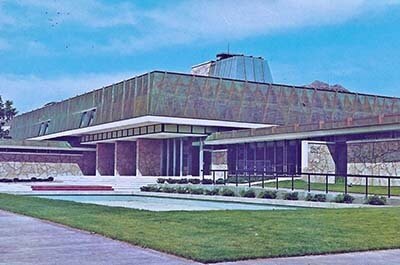
Fremont County Administration Building
 The Fremont County Administration Building was dedicated in 1961 and served as the County Courthouse until a new judicial building was built in 1999. Designed by the Denver architectural firm of Nixon & Jones, the building incorporates natural stone panels on both the interior and exterior walls that was quarried in the nearby Cowan Quarry. The building was designated a Fremont County Landmark in 2014.
The Fremont County Administration Building was dedicated in 1961 and served as the County Courthouse until a new judicial building was built in 1999. Designed by the Denver architectural firm of Nixon & Jones, the building incorporates natural stone panels on both the interior and exterior walls that was quarried in the nearby Cowan Quarry. The building was designated a Fremont County Landmark in 2014.
Fremont County Administration Building
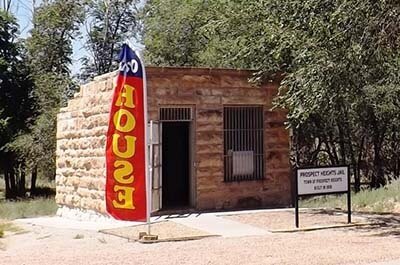
Prospect Heights Jail
 The Prospect Heights Jail was built in 1906 and was the only municipal building for the Town of Prospect Heights, previously a Slavic enclave of mine workers near the Nonac Coal Mine. The enterprising residents incorporated in 1905 to take advantage of absence of saloons in the neighboring “dry” communities of Cañon City and South Cañon. The jail was built to incarcerate the disorderly drunks who frequented the seven or eight saloons and other establishments operating twenty-four hours a day.
The Prospect Heights Jail was built in 1906 and was the only municipal building for the Town of Prospect Heights, previously a Slavic enclave of mine workers near the Nonac Coal Mine. The enterprising residents incorporated in 1905 to take advantage of absence of saloons in the neighboring “dry” communities of Cañon City and South Cañon. The jail was built to incarcerate the disorderly drunks who frequented the seven or eight saloons and other establishments operating twenty-four hours a day.
Prospect Heights Jail
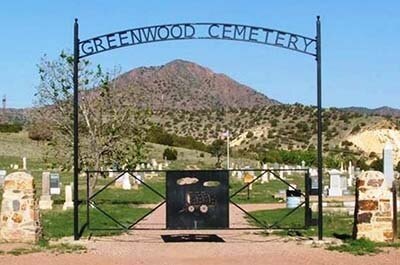
Greenwood Cemetery
 Greenwood Pioneer Cemetery is the second known burial ground in Cañon City and has a long and significant history. The persons buried there have shaped not only the local history of Cañon City, but in many instances the history of the state of Colorado.
Greenwood Pioneer Cemetery is the second known burial ground in Cañon City and has a long and significant history. The persons buried there have shaped not only the local history of Cañon City, but in many instances the history of the state of Colorado.
Greenwood Cemetery
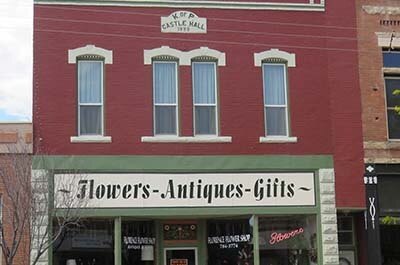
Castle Hall of the Knights of Pythias
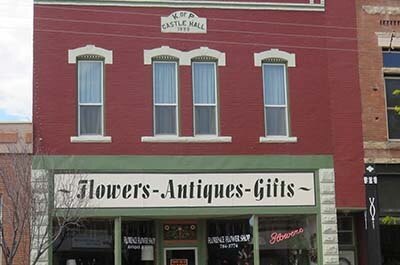 101 W, Main St. in Florence.
101 W, Main St. in Florence.
The Castle Hall of the Knights of Pythias was erected in 1888 as the first commercial brick building on Main Street in Florence. Originally the basement level of the building was entered from the street, but severe flooding in 1921 caused Main Street to be raised many feet and the basement entrance was sealed. The building provided a popular hall for social events, balls, weddings and meetings.
This Landmark is part of the Florence, Colorado Self Guided Tour.
Download This TourCastle Hall of the Knights of Pythias
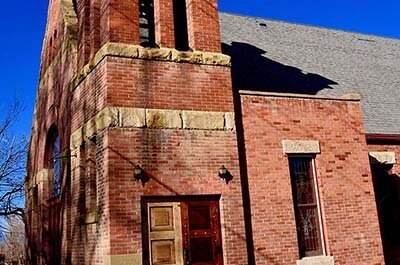
Bell Tower Culture Center
 Bell Tower Cultural Center served as the First Baptist Church of Florence from its construction in 1899 until it was donated by its congregation as an arts center to the Florence Arts Council in 2013. A basement was dug under the sanctuary in 1927 to provide Sunday School space. The bell was donated by a Pagosa Springs church in 1939. (Damon Kurtz photo)
Bell Tower Cultural Center served as the First Baptist Church of Florence from its construction in 1899 until it was donated by its congregation as an arts center to the Florence Arts Council in 2013. A basement was dug under the sanctuary in 1927 to provide Sunday School space. The bell was donated by a Pagosa Springs church in 1939. (Damon Kurtz photo)
Bell Tower Culture Center

Deputy Warden's House
 Deputy Warden’s House was built in 1901 by architect C.C. Rittenhouse using prison labor to quarry the stone. The three story tower that dominates the facade of the house is the most prominent architectural feature of the building.
Deputy Warden’s House was built in 1901 by architect C.C. Rittenhouse using prison labor to quarry the stone. The three story tower that dominates the facade of the house is the most prominent architectural feature of the building.
Deputy Warden’s House
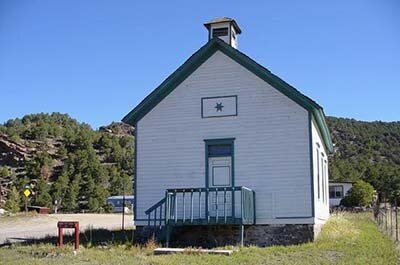
Old Howard Church
 This frame church was constructed in 1898 by it’s membership. During the Great Depression, the membership could no longer support a preacher so the little church was abandoned by the Free Methodist Conference.
This frame church was constructed in 1898 by it’s membership. During the Great Depression, the membership could no longer support a preacher so the little church was abandoned by the Free Methodist Conference.
Old Howard Church
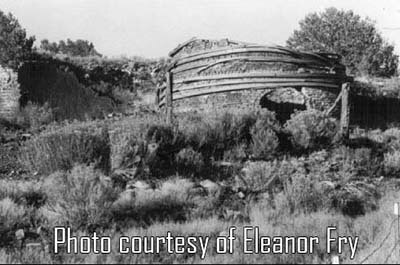
Coaldale Charcoal Kilns
 The Coaldale Charcoal Kilns were among many kilns in Western Fremont County built to provide fuel for ore processing in Pueblo, Salida and Leadville. The Denver & Rio Grande Railroad served the upper Arkansas River valley and hauled Charcoal. These were further from the Railroad than most. Photo courtesy of Eleanor Fry.
The Coaldale Charcoal Kilns were among many kilns in Western Fremont County built to provide fuel for ore processing in Pueblo, Salida and Leadville. The Denver & Rio Grande Railroad served the upper Arkansas River valley and hauled Charcoal. These were further from the Railroad than most. Photo courtesy of Eleanor Fry.
This Landmark is part of the Western Fremont County Self-Guided Tour
Download the Tour
Coaldale Charcoal Kilns
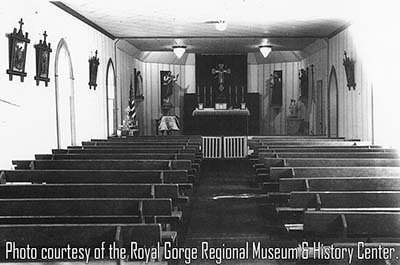
St. Anthony's Catholic Church
 St. Anthony’s Catholic Church in the Town of Brookside is an unadorned, Carpenter Gothic building with a steeply-pitched roof and square bell-tower that served from the late 1870s or 1880s as the Brewster Schoolhouse. In 1920, it was purchased and moved to Brookside by horse teams and rededicated as St. Anthony’s Catholic Church. From 1920 to 1988, it was a vital part of this largely Italian-American community and hosted numerous community events such as St. Anthony’s Day celebrations. Vacant since 1988, it was acquired by the Town in 2013 for future use serving the community.
St. Anthony’s Catholic Church in the Town of Brookside is an unadorned, Carpenter Gothic building with a steeply-pitched roof and square bell-tower that served from the late 1870s or 1880s as the Brewster Schoolhouse. In 1920, it was purchased and moved to Brookside by horse teams and rededicated as St. Anthony’s Catholic Church. From 1920 to 1988, it was a vital part of this largely Italian-American community and hosted numerous community events such as St. Anthony’s Day celebrations. Vacant since 1988, it was acquired by the Town in 2013 for future use serving the community.
Photo courtesy of the Royal Gorge Regional Museum & History Center.
St. Anthony’s Catholic Church
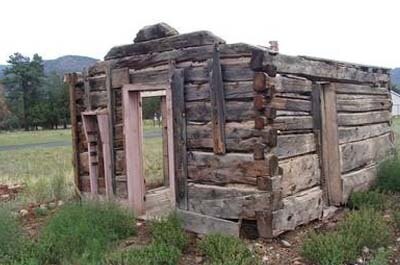
Julius M. Parker Homestead
 The Julius M. Parker Homestead in Coaldale was patented in 1893. (Carol McNew photo)
The Julius M. Parker Homestead in Coaldale was patented in 1893. (Carol McNew photo)
Julius M. Parker Homestead

Vista Lodge
 The Reel California Girls built the 40-foot by 60-foot Vista Lodge out of local stone and cement in 1920 on the Priest Canyon Road going up to the Gorge and operated it for several years. The two women, Cora Augusta Beardsley and Ethelyndal McMullin, were both bit part actresses in silent films; Cora was also a camerawoman (one of the first) and Ethelyndal had been in vaudeville acts and plays. In the pre-Hollywood era, Cañon City was a center of production for silent films. The Reel California Girls arrived in Cañon City August of 1916 by automobile from Alameda, California. Later, they developed a set of plans and a dream to build a summer resort in the Royal Gorge Park near the north rim where they could promote their burlesque acts and provide a place for entertainment near the Gorge. The Vista Lodge was an accommodating, elegant place to visit and an impressive structure for its time, it included a 16-foot by 30-foot dining room with a hardwood floor for dancing. The nice sized windows were on three sides for cool breezes and a cozy fireplace for guests to sit by. Dinner was served from six o’clock until midnight and the featured dinner was “southern fried chicken” which was Ethlyndal’s specialty. Visitors from Colorado Springs and Denver were known to have driven to the Vista Lodge for just that special dinner. The two women would advertise in the local newspaper about having a five-piece orchestra from California play dance music. Furnished cabins were available for rent, there was a campground and picnic baskets filled with fried chicken or rabbit with all the trimmings could be purchased. They had a cistern close to the road for overheated automobiles (the road included a steep grade!) The building was destroyed by fire in 1925 and not rebuilt. What remained was further damaged by the Royal Gorge Fire of 2013.
The Reel California Girls built the 40-foot by 60-foot Vista Lodge out of local stone and cement in 1920 on the Priest Canyon Road going up to the Gorge and operated it for several years. The two women, Cora Augusta Beardsley and Ethelyndal McMullin, were both bit part actresses in silent films; Cora was also a camerawoman (one of the first) and Ethelyndal had been in vaudeville acts and plays. In the pre-Hollywood era, Cañon City was a center of production for silent films. The Reel California Girls arrived in Cañon City August of 1916 by automobile from Alameda, California. Later, they developed a set of plans and a dream to build a summer resort in the Royal Gorge Park near the north rim where they could promote their burlesque acts and provide a place for entertainment near the Gorge. The Vista Lodge was an accommodating, elegant place to visit and an impressive structure for its time, it included a 16-foot by 30-foot dining room with a hardwood floor for dancing. The nice sized windows were on three sides for cool breezes and a cozy fireplace for guests to sit by. Dinner was served from six o’clock until midnight and the featured dinner was “southern fried chicken” which was Ethlyndal’s specialty. Visitors from Colorado Springs and Denver were known to have driven to the Vista Lodge for just that special dinner. The two women would advertise in the local newspaper about having a five-piece orchestra from California play dance music. Furnished cabins were available for rent, there was a campground and picnic baskets filled with fried chicken or rabbit with all the trimmings could be purchased. They had a cistern close to the road for overheated automobiles (the road included a steep grade!) The building was destroyed by fire in 1925 and not rebuilt. What remained was further damaged by the Royal Gorge Fire of 2013.
Vista Lodge
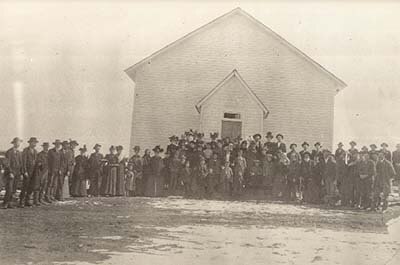
New Hope Church and Cemetery
 North of Wetmore, Colorado just off County Road 295 on CR 19. A sign marks its location 1.6 miles north of Colorado Highway 96. (Photo 1898)
North of Wetmore, Colorado just off County Road 295 on CR 19. A sign marks its location 1.6 miles north of Colorado Highway 96. (Photo 1898)
Built to serve the settlers of Hardscrabble Park, the New Hope Church was completed in 1873 and is the second oldest Baptist church in Colorado. The first church list consisted of 110 members, and Elder S. B. Chastine served as the first Pastor. Ira Porter donated the land, and the church was built by the congregation. The wood frame is assembled by mortised joints and wooden pegs. No nails were used in the construction. The floor joists are hand hewn lodge poles and pine logs with tongue and groove assembly. Square nails were used to attach the roof and siding. The pulpit and pews were handmade by the members. Vinyl siding was put on in the early 1980’s to help preserve the building.
Burials began at the New Hope Cemetery in 1870 and continue today. As of 2016 there are 605 known burials at the cemetery. Of those, 49 are Veterans who served in the Civil War, Mexican War, WWI, WWII, Korean Conflict and Vietnam War.
Photo from the archives of Peggy Breece Martin
New Hope Church and Cemetery
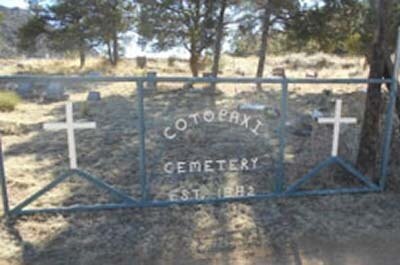
Cotopaxi Cemetery
 The Cotopaxi Cemetery was started in 1882 on land donated by Emanuel H. Saltiel, a miner, promoter and entrepreneur, to bury four young residents of the Russian Jewish Agricultural Colony which he had drawn to the area. The Agricultural Colony struggled for a few years before failing, partially because of the lack of promised equipment and supplies as well as poor land. The Colonists were left to work for the Railroad, recently completed in the area, or Saltiel’s copper mine, located just west of the cemetery. Veterans from the Civil War (both Union and Confederate), Spanish American War, WWI, WWII, Korea and Vietnam were laid to rest here as well as pioneer families who homesteaded the land. The first white child born in the Pleasant Valley of Western Fremont County is here as are family members of Outlaw Gangs, who frequented this remote area in the early days. The cemetery is located on CR-12 just past the Cotopaxi school. The cemetery is open to visitors and many family plots are maintained with perennial irises and shrubs along with natural rocks over the graves. Many of the head stones are natural granite from the local quarries.
The Cotopaxi Cemetery was started in 1882 on land donated by Emanuel H. Saltiel, a miner, promoter and entrepreneur, to bury four young residents of the Russian Jewish Agricultural Colony which he had drawn to the area. The Agricultural Colony struggled for a few years before failing, partially because of the lack of promised equipment and supplies as well as poor land. The Colonists were left to work for the Railroad, recently completed in the area, or Saltiel’s copper mine, located just west of the cemetery. Veterans from the Civil War (both Union and Confederate), Spanish American War, WWI, WWII, Korea and Vietnam were laid to rest here as well as pioneer families who homesteaded the land. The first white child born in the Pleasant Valley of Western Fremont County is here as are family members of Outlaw Gangs, who frequented this remote area in the early days. The cemetery is located on CR-12 just past the Cotopaxi school. The cemetery is open to visitors and many family plots are maintained with perennial irises and shrubs along with natural rocks over the graves. Many of the head stones are natural granite from the local quarries.
Cotopaxi Cemetery
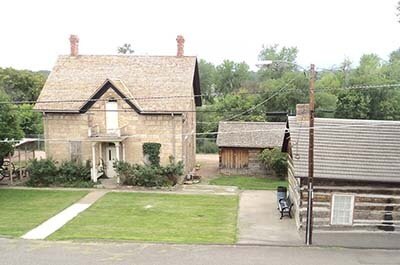
Rudd House and Cabin
 Early settler and one of Cañon City’s founding fathers, Anson Rudd built his log cabin on this site in 1860. In 1881, Anson Rudd constructed his stone house with stone quarried from the local prison right beside his cabin. A blacksmith by trade, Anson Rudd served as postmaster, county sheriff, a warden at the Territorial Prison, and as county commissioner. Rudd also helped to establish the boundaries of Fremont County. Both the Anson Rudd House and Cabin are listed on the Colorado State Register of Historic Properties.
Early settler and one of Cañon City’s founding fathers, Anson Rudd built his log cabin on this site in 1860. In 1881, Anson Rudd constructed his stone house with stone quarried from the local prison right beside his cabin. A blacksmith by trade, Anson Rudd served as postmaster, county sheriff, a warden at the Territorial Prison, and as county commissioner. Rudd also helped to establish the boundaries of Fremont County. Both the Anson Rudd House and Cabin are listed on the Colorado State Register of Historic Properties.
Rudd House and Cabin Site
